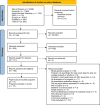Sexual and Dating Violence Prevention Programs for Male Youth: A Systematic Review of Program Characteristics, Intended Psychosexual Outcomes, and Effectiveness
- PMID: 37226034
- PMCID: PMC10684717
- DOI: 10.1007/s10508-023-02596-5
Sexual and Dating Violence Prevention Programs for Male Youth: A Systematic Review of Program Characteristics, Intended Psychosexual Outcomes, and Effectiveness
Erratum in
-
Correction: Sexual and Dating Violence Prevention Programs for Male Youth: A Systematic Review of Program Characteristics, Intended Psychosexual Outcomes, and Effectiveness.Arch Sex Behav. 2023 Oct;52(7):2937. doi: 10.1007/s10508-023-02664-w. Arch Sex Behav. 2023. PMID: 37488272 Free PMC article. No abstract available.
Abstract
Sexual and dating violence (SDV) by male youth (≤ 25 years)-including sexual harassment, emotional partner violence, and rape-is a worldwide problem. The goal of this preregistered (PROSPERO, ID: CRD42022281220) systematic review was to map existing SDV prevention programs aimed at male youth, including their characteristics (e.g., content, intensity), intended psychosexual outcomes, and empirically demonstrated effectiveness, guided by the principles of the theory of planned behavior (TPB). We conducted searches in six online databases for published, peer-reviewed quantitative effectiveness studies on multi-session, group focused, and interaction based SDV prevention programs for male youth ending March 2022. After screening of 21,156 hits using PRISMA guidelines, 15 studies on 13 different programs, from four continents were included. Narrative analysis showed, first, broad ranges in program intensity (2-48 h total), and few program curricula included explicit discussion of relevant aspects of the TPB. Second, programs' main intended psychosexual outcomes were to change SDV experiences, or related attitudes, or norms. Third, significant effects were found mostly on longer term behaviors and short-term attitudes. Other theoretical proxies of SDV experiences, such as social norms and perceived behavioral control, were sparsely investigated; thus, program effectiveness on these outcomes remains largely unknown. Assessed with the Cochrane Risk of Bias Tool, moderate to serious risk of bias arose in all studies. We present concrete suggestions for program content, such as explicit attention to victimization and masculinity and discuss best practices for evaluation research, including assessments of program integrity, and examining relevant theoretical proxies of SDV.
Keywords: Adolescent boys; Sexual education; Sexual health; Sexual violence; Structured literature review.
© 2023. The Author(s).
Conflict of interest statement
All authors certify that they have NO affiliations with or involvement in any organization or entity with any financial interest (such as honoraria; educational grants; participation in speakers’ bureaus; membership, employment, consultancies, stock ownership, or other equity interest; and expert testimony or patent-licensing arrangements), or non-financial interest (such as personal or professional relationships, affiliations, knowledge or beliefs) in the subject matter or materials discussed in this manuscript.
Figures
Similar articles
-
A cluster-randomized trial of a middle school gender violence prevention program: Design, rationale, and sample characteristics.Contemp Clin Trials. 2017 Nov;62:11-20. doi: 10.1016/j.cct.2017.08.007. Epub 2017 Aug 15. Contemp Clin Trials. 2017. PMID: 28821469 Clinical Trial.
-
Linkages between violence-associated attitudes and psychological, physical, and sexual dating abuse perpetration and victimization among male and female adolescents.Aggress Behav. 2019 Nov;45(6):622-634. doi: 10.1002/ab.21856. Epub 2019 Aug 25. Aggress Behav. 2019. PMID: 31448435 Free PMC article.
-
Severe dating violence and quality of life among south carolina high school students.Am J Prev Med. 2000 Nov;19(4):220-7. doi: 10.1016/s0749-3797(00)00227-0. Am J Prev Med. 2000. PMID: 11064224
-
Updates on adolescent dating and sexual violence prevention and intervention.Curr Opin Pediatr. 2018 Aug;30(4):466-471. doi: 10.1097/MOP.0000000000000637. Curr Opin Pediatr. 2018. PMID: 29750769 Free PMC article. Review.
-
Efficacy of Interventions to Prevent Physical and Sexual Dating Violence Among Adolescents: A Systematic Review and Meta-analysis.JAMA Pediatr. 2022 Feb 1;176(2):142-149. doi: 10.1001/jamapediatrics.2021.4829. JAMA Pediatr. 2022. PMID: 34842911 Free PMC article.
Cited by
-
"I Think You Covered the Three Levels of Drugs and Consent": Qualitatively Testing Different Operationalizations of an Alcohol and Other Drugs-Involved Sexual Violence.Arch Sex Behav. 2024 Oct;53(9):3595-3608. doi: 10.1007/s10508-024-02947-w. Epub 2024 Jul 22. Arch Sex Behav. 2024. PMID: 39039340 Free PMC article.
-
Preventing Sexual Violence: A Behavioral Problem Without a Behaviorally Informed Solution.Psychol Sci Public Interest. 2024 May;25(1):4-29. doi: 10.1177/15291006231221978. Psychol Sci Public Interest. 2024. PMID: 38832574 Free PMC article. Review.
-
Psychometric Validation of the Dating Violence Questionnaire (DVQ-R) in Ecuadorians.Behav Sci (Basel). 2025 Jan 15;15(1):68. doi: 10.3390/bs15010068. Behav Sci (Basel). 2025. PMID: 39851872 Free PMC article.
-
An Online Program for Sexual and Gender Minority Youth Reduces Alcohol Use and Teen Dating Violence: A Randomized Controlled Trial.J Stud Alcohol Drugs. 2025 Mar;86(2):287-296. doi: 10.15288/jsad.24-00007. Epub 2025 Feb 3. J Stud Alcohol Drugs. 2025. PMID: 39895618 Clinical Trial.
-
A Qualitatively-Informed Approach to Examining the Construct Validity of Alcohol-Involved Sexual Violence.Sex Cult. 2025;29(3):1297-1317. doi: 10.1007/s12119-025-10324-5. Epub 2025 Jan 29. Sex Cult. 2025. PMID: 40386565 Free PMC article.
References
-
- Adams J, Hillier-Brown FC, Moore HJ, Lake AA, Araujo-Soares V, White M, Summerbell C. Searching and synthesising ‘grey literature’and ‘grey information’ in public health: Critical reflections on three case studies. Systematic Reviews. 2016;5(1):1–11. doi: 10.1186/s13643-016-0337-y. - DOI - PMC - PubMed
-
- Ajzen I. The theory of planned behavior. Organizational Behavior and Human Decision Processes. 1991;50(2):179–211. doi: 10.1016/0749-5978(91)90020-T. - DOI
-
- Anderson LA, Whiston SC. Sexual assault education programs: A meta-analytic examination of their effectiveness. Psychology of Women Quarterly. 2005;29(4):374–388. doi: 10.1111/j.1471-6402.2005.00237.x. - DOI
Publication types
MeSH terms
Grants and funding
LinkOut - more resources
Full Text Sources
Medical



